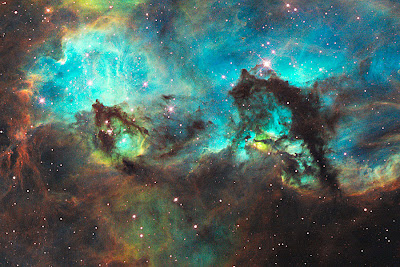Above is a picture of a seahorse in the Large Magellanic Cloud, a nearby satellite galaxy of the Milky Way. What looks to us like a seahorse (an example of pareidolia, the same phenomenon that lets us see constellations in groups of stars and the man in the moon) is actually a pillar of dust 20 lightyears long.
The seahorse is very close to another well-known object in the LMC, the Tarantula Nebula:
The Tarantula Nebula is very energetic, and is in the process of forming a star cluster, the center of which is just above the cutoff of the Seahorse image. As stars form in the cluster, the resulting solar wind will slowly erode the Seahorse dust pillars over the next million years or so.
I think it is often pictures like this that first get people interested in astronomy. There are several reasons for this. The first is rather obvious: they look really cool. Pictures of astronomical objects can be really artistic, and sometimes breathtaking in their patterns and complexity. This can be enhanced when one is able to see something familiar in the picture, like the Magellanic Cloud's Seahorse.
But then there's another dimension. It's fun to imagine a seahorse in the picture, but it's even more interesting to learn what the image really is. A towering pillar of smoky dust, billowing and reforming as the nearby nebula grows and grasps it ever more tightly. It's a monument taller than the highest skyscraper we will ever build, and it's over 150,000 lightyears away, a distance greater than we could possibly imagine. Yet through the technology of the Hubble Telescope, we are able to gaze into the deep, dark night, and find a seahorse sculpted by gravity and eons.


wow, this is really poetic. love it!
ReplyDelete